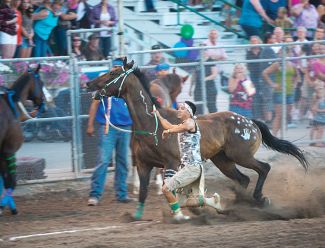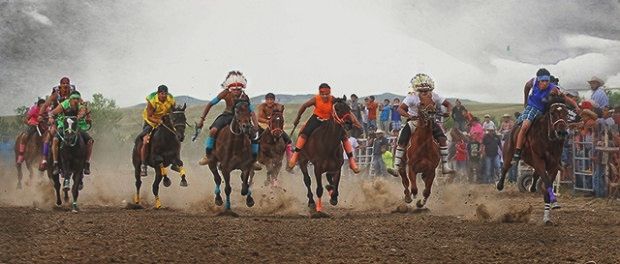 |
Canku Ota
|
 |
|
(Many Paths)
|
||
|
An Online Newsletter
Celebrating Native America
|
||
|
September 2015 - Volume
13 Number 9
|
||
|
|
||
|
Behind The Scenes
With Indian Relay Racing
|
||
|
by Clara Caufield, Native
Sun News Correspondent
|
||
|
Relay racing is now a major Indian rodeo event. Yet, media coverage of this wild melee is normally limited to an amazing photo of the winning team, colorful and bold. This article, originally published by the Native Sun News, is about what goes on behind the scenes.
CROW AGENCY, Mont. – Ashton Old Elk, age 24, jockey and trainer for the Old Elk Indian Relay Racing Team, recently shared his views on what it takes to field a competitive Indian relay racing team. Interviewed on Sunday, Aug. 16 at the Crow horse barns, he responded to questions while engaged in a more important task: bathing his team of three top thoroughbreds in preparation for the championship heat that included a $15,000 purse provided by the Crow Tribe. Later that day, his team placed third out of field of 20. The Old Elk team, with the support/sponsorship of Leroy Whiteman, Northern Cheyenne, has been chasing a national title since 2005. Generally in the money (placing second or third on a regular basis), they were successful in 2013 at the Sheridan, Wyoming, rodeo winning it all, but that was a year before the sport was formally organized and sanctioned. So, they have another championship in mind. The team includes Ashton; his brothers, Shawnley Old Elk and Joe Reed; and his uncle Esley Old Elk. Whiteman, a veteran Indian relay racer, emphasizes that Indian Relay requires the participation of the entire extended family, who all get involved, providing financial and critical moral support. "That is why the sport is possible," he explained. "Even if you win, there isn't much money to be realized, the expenses being so great – acquiring horses, feed, travel, entry fees, etc. Everyone is there, helping and watching out. The other teams offer cooperation and support, wishing each other safety and luck. It's a unique Indian thing," he said. Ashton has been jockey for 13 years, going back to the Lodge Grass Park where he and young companions mounted ponies, racing against one another for fun, with an eye to the future. That is where the young Crow athlete learned about "exchanges" (gracefully and quickly leaping from one racing steed to another) - the key to relay race victory- generally accomplished in three seconds or less.
The Old Elk racing legacy was started by Esley Old Elk in 2005. Racing requires a four-man team: the jockey, a mugger, catcher and a holder -all essential. Depending upon the track, three laps ranging from one-half to 7/8 of a mile are raced, using three different horses. Thoroughbreds are the favored breed of horse, although appendix bred (quarter horse-thoroughbred cross) are often included in the mix. The Old Elks pride themselves for using Crow bred horses - or sometimes including a Cheyenne bred horse - provided by Whiteman. Training, they explain, is the key. "I live with these horses," Ashton said. "It is a daily thing. Sweet feed, oats and good quality hay are very important. They have to be fed on a regular routine, breakfast, lunch and supper. They count on me for that, greeting me each day." "While they are eating, I muck the stalls and do other work to keep them up," he said. "I'm here dawn to dark." Ashton maintains a regular training schedule. Each of the seven horses is religiously exercised, going several times around the Crow track, 7/8 of a mile, the rate determined by their condition. "Usually in the evening when it is cooler," he explained. "But sometimes I work them in the early morning when the air is thinner. That builds up their lungs. Then I take them to the nearby river, letting them stand in the cool water, good for their legs," he said. Several of the horses in Old Elk's current string were determined problems, given up on by other trainers. "I give them a chance to be a horse," said the young trainer. "Do something besides run races. When they get used to that and to me, they calm down." Esley concurred. "The horses depend on us. They reflect our attitude. If we are calm during a race, they will be too. If we are nervous, they will be too." That was entirely evident as the young jockey bathed his horses who stood quietly, entirely at liberty as he reassured them in a friendly tone. "We are friends," he smiled. It is necessary, Old Elk says to have a stable of seven horses against the odds of injury. While a team of three is necessary for each 3-4 heats of competition, the horses can be exchanged. "A thoroughbred horse will run good one day, not so good the next and then be faster on the last heat," he suggests. "That is why we rotate horses for each heat. They are all good runners, but some have better days than others. Just like people." Before each race, the selected horses are prepared with prayer and painted with the handed-down Crow symbols: lightening and an arrow. "This is for protection," said Esley. Ashton, the epitome of a warrior at 6 foot and 150 pounds, prepares as well, donning protective paint, bandana, a single eagle feather, buckskins and moccasins. "We like to look good," he teases. And they do. "There is no doubt in my mind that they will win the National Championship one day," said Leroy Whiteman who has fielded two national champion teams during his career. "They have what it takes. I believe in them."
|
|||||
|
|
|
|
||
|
|
||
| Canku Ota is a free Newsletter celebrating Native America, its traditions and accomplishments . We do not provide subscriber or visitor names to anyone. Some articles presented in Canku Ota may contain copyright material. We have received appropriate permissions for republishing any articles. Material appearing here is distributed without profit or monetary gain to those who have expressed an interest. This is in accordance with Title 17 U.S.C. Section 107. | ||
|
Canku Ota is a copyright ©
2000 - 2015 of Vicki Williams Barry and Paul Barry.
|
||
 |
 |
|
|
The "Canku
Ota - A Newsletter Celebrating Native America" web site and
its design is the
|
||
|
Copyright ©
1999 - 2015 of Paul C. Barry.
|
||
|
All Rights Reserved.
|
||


